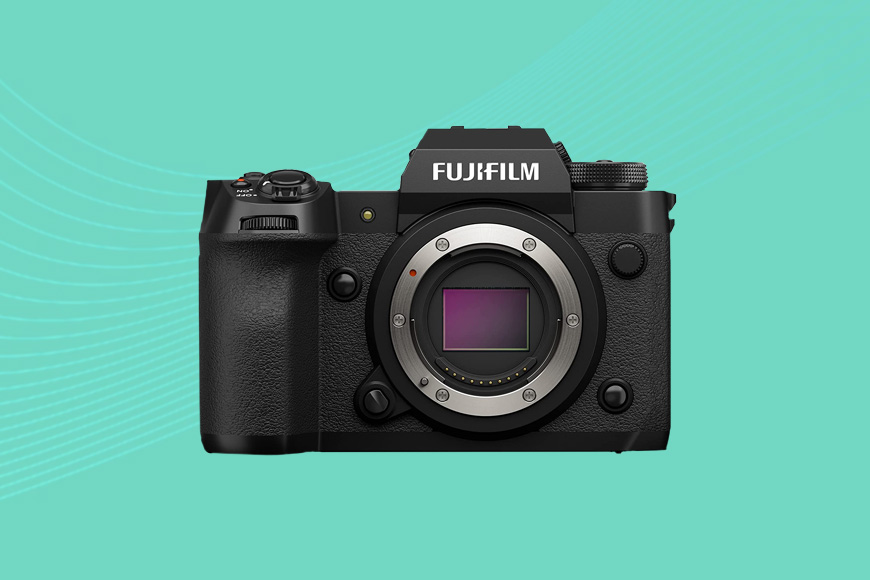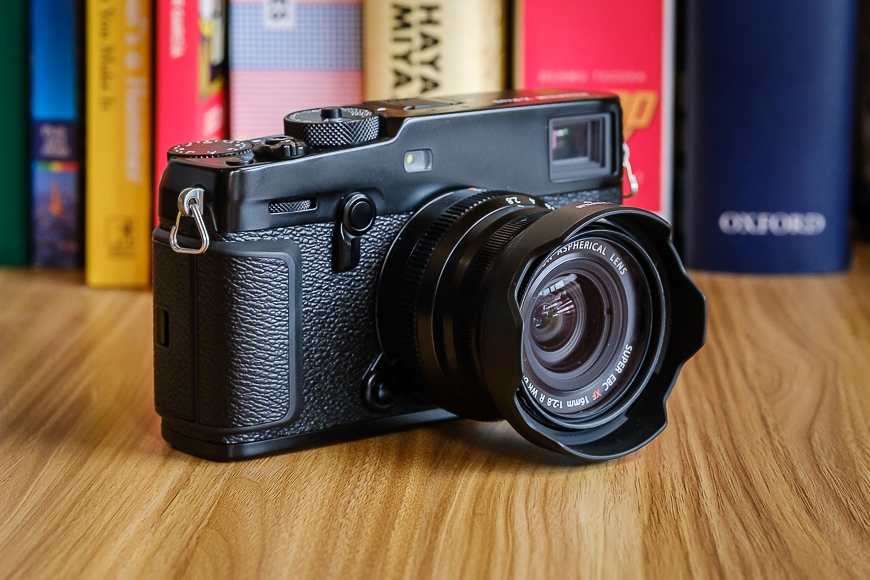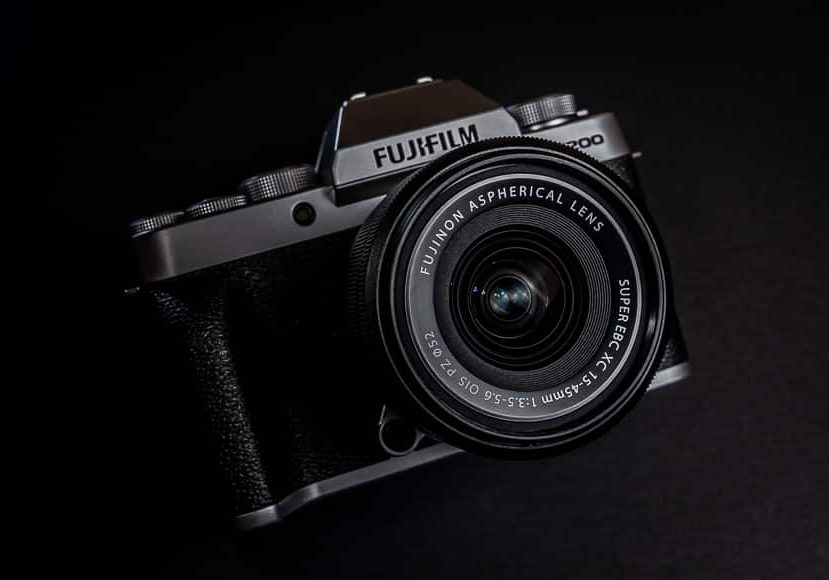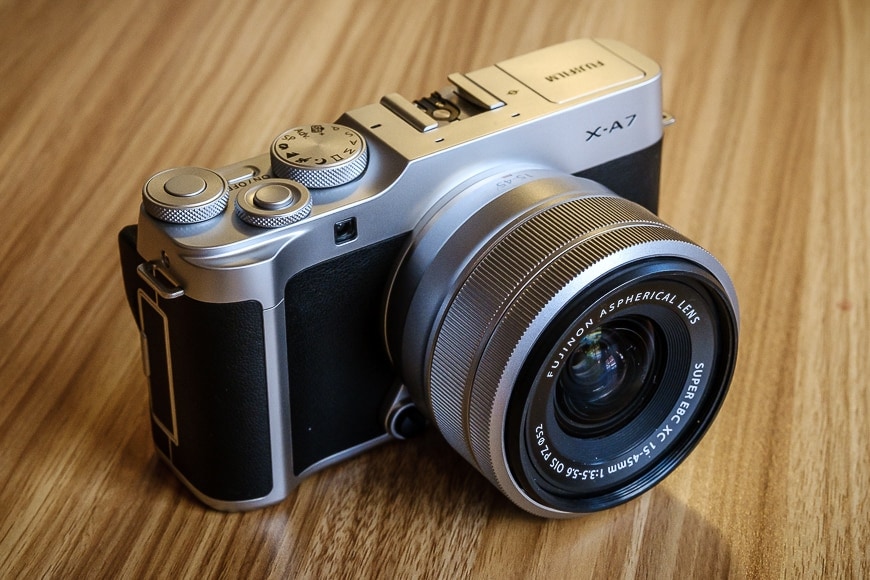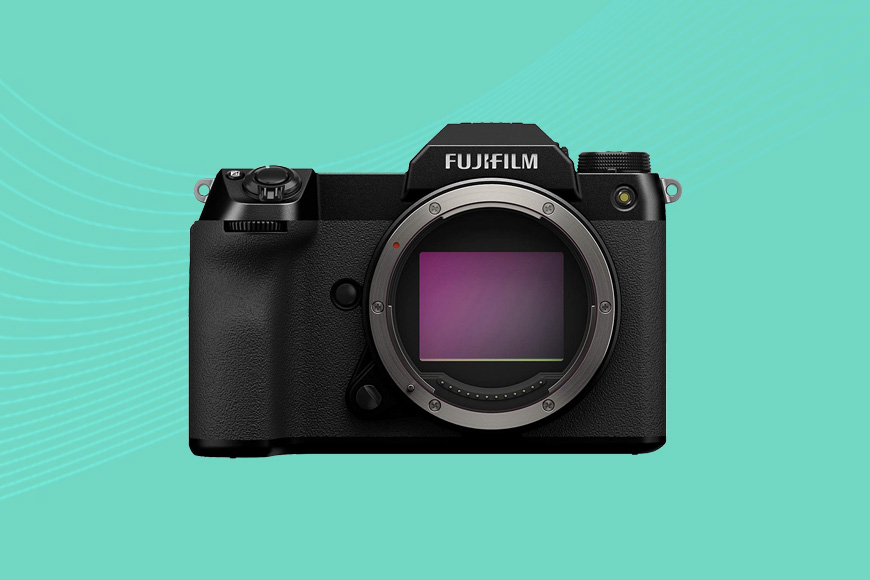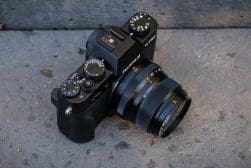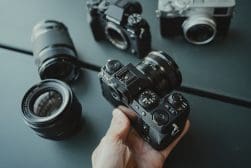
Best Fujifilm Cameras of 2024 (Latest Fuji X-Mount Models)
Discover the best Fujifilm cameras on the market, expertly reviewed to help you choose the perfect model for your photography and film-making needs.
Camera Gear Guides | Camera Guides | By Mark Condon and Andrew Dilks | Last Updated: January 3, 2024
This guide will help you choose the best Fujifilm camera for your photography and film-making needs.
I’ve been shooting with Fujifilm X-Series cameras for years and love their aesthetics and image quality.
There are simply no better digital cameras that look like film cameras or produce better-looking JPEGs.
From fixed lens compacts to full-featured interchangeable lens bodies, there’s a Fuji camera for everyone.
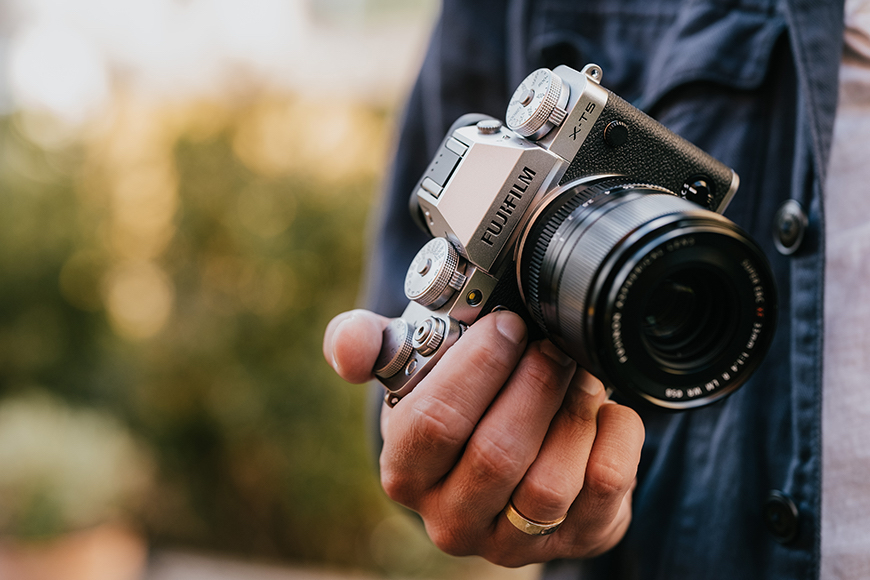
Improved autofocus and image stabilisation combined with a glorious new 40MP sensor makes this good-looking camera the most desirable X-T model yet.
Fujifilm’s continuous improvement philosophy (‘kaizen’) provides consistent firmware updates to keep its existing product line fresh.
They also have a habit of releasing plenty of new X-Series cameras, Fuji lenses and Fuji accessories each year, meaning there’s a lot to choose from.
In this guide, I’ve attempted to cut through all the noise and offer my recommendations for the top Fuji cameras in 2024.
Let’s take a closer look.
What is the Best Fujifilm Camera in 2024?
| Image | Product | Features | |
|---|---|---|---|
 | Fujifilm X-T5OUR #1 CHOICE |
| Check AMAZON Price → Check B&H Price → |
 | Fujifilm X-H2BEST CUTTING EDGE FEATURES |
| Check AMAZON Price → Check B&H Price → |
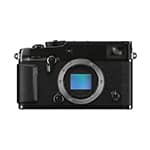 | Fujifilm X-Pro3BEST INCOGNITO FOR PROS |
| Check AMAZON Price → Check MOMENT Price → |
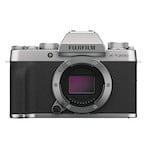 | Fujifilm X-T200BEST BUDGET FUJI |
| Check Amazon Price → |
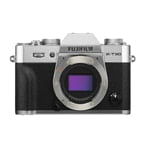 | Fujifilm X-T30BEST VALUE ALLROUND |
| Check Amazon Price → |
 | Fujifilm X-A7FLEXIBLE POINT & SHOOT |
| Check Amazon Price → |
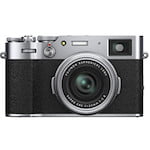 | Fujifilm X100VBEST FOR SIMPLE TRAVEL |
| Check AMAZON Price → Check MOMENT Price → |
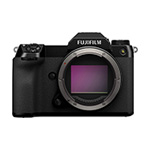 | Fujifilm GFX100SCOMPETITIVELY PRICED |
| Check AMAZON Price → Check B&H Price → |
 | Fujifilm GFX 100BEST IMAGE QUALITY |
| Check AMAZON Price → Check MOMENT Price → |
 | Fujifilm X-T30 II |
| Check AMAZON Price → Check B&H Price → |
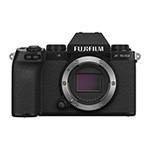 | Fujifilm X-S10 |
| Check AMAZON Price → Check B&H Price → |
1. Fujifilm X-T5 | All Round Best Fujifilm Camera
Size: 130 mm x 91 mm x 64 mm
Weight: 607g
Sensor: APS-C sensor (23.5 x 15.6 mm)
Megapixels: 40.2MP
- Wonderful handling experience
- High-quality 40.2MP APS-C sensor
- Accurate subject-tracking autofocus
- Plenty of video modes
- Extended battery life
- Decent in-body stabilisation
- Burst shooting has a limited buffer
- Overall autofocus performance could be better
- Unable to add a vertical battery grip
Fujifilm’s X-T series of flagship cameras have continued to thrill hobbyist photographers who are looking for a versatile photo-centric shooting experience that combines great performance with a classic style.
Slightly smaller than the X-T4, the X-T5 feels wonderful to use, with its ergonomic design and dials delivering a tactile and responsive shooting experience that’s perfect for adventurous photographers who want to keep the weight down.
The Fujifilm X-T5 retains the old-school design aesthetics of its predecessors, with the film camera-style dials granting quick access to the camera’s various modes, ISO settings, and shutter speed.
Most of these dials can be easily customised and remain identical to those found on the X-T4, and adjusting the various settings can be quickly achieved through the Q menu system available via the touchscreen.
This screen has received an upgrade in resolution, now displaying up to 1.84 million dots, although Fujifilm has taken a step back from the fully articulating screen found on the previous model, and it can be a tad unresponsive when used for setting focus points.
The Fujifilm X-T5 brings in several new upgrades and features not found on the X-T4 making it a worthy upgrade, despite the more than capable predecessor.
These include much improved in-body stabilisation for smoother handheld shots, an improved mechanical shutter mechanism rated up to 15fps, and significant improvements to the camera’s battery life.
The new addition of a 40MP APS-C X-Trans CMOS 5 HR BSI Sensor is among the biggest draws to this latest iteration in the series, coming over from the more expensive X-H2 and delivering crisper and sharper images with more detail to play with in the edit.
Upgraded autofocus, which includes subject detection for a variety of animals as well as cars, trains, and aeroplanes, is also a welcome new feature to the X-T5, even if the overall autofocus performance remains slower than some of its closest rivals from Sony and Canon.
The addition of great IBIS is a notable improvement on this impressive Fujifilm digital camera, allowing for better compositions of images with a wide range of lenses while also working in conjunction with the Pixel Shift Multi-Shot mode, another port from the X-H2.
Fujifilm has managed to improve the IBIS on the X-T5 from its predecessor, with up to 7.0EV and ‘IS Boost’ mode managing to act as a substitute for a tripod for handheld shots at slower shutter speeds.
The various Film Simulation modes found in the previous model are all here, with 19 modes in total that allow you to replicate the aesthetics of a selection of classic film stocks that Fujifilm has developed over the past few decades.
These modes are incredibly popular with Fujifilm camera enthusiasts, and for good reason; easy to use, they open up a new world of creative possibilities without the need for time-consuming post-processing and grading.
The Fujifilm X-T5 shines when utilising the options to tweak the look of in-camera JPGs, delivering its trademark warmth of colour and depth of tone that users have come to expect, particularly when working with Fuji’s native lenses.
While the Fujifilm X-T5 favours photography over videography, there is still a lot of fun to be had when using this for filmmaking and content creation, capable of shooting nice 6.2K/30p and 4K/60p video footage.
If you’re looking for a true hybrid camera, or want to place an emphasis on videography, the absence of a headphone jack and the rather flimsy micro-HDMI port might be a turn-0ff, as well as the aforementioned absence of the flip-out variable-angle rear screen from the X-T4.
Overall, the strengths exhibited in Fujifilm’s latest entry into the X-T series far outweigh any weaknesses, particularly when it comes to the quality of stills, which are much-improved thanks to the upgraded processor and sensor.
Who is the Fujifilm X-T5 for?
The Fujifilm X-T5 is another impressive entry in their flagship series that brings in some handy new features and improvements over its predecessor, even though it has taken a slight step back from the X-T4 in terms of videography.
Amateurs and hobbyists who focus on photography are clearly the target audience here, with the throwback design, functionality, and lightweight size making this a great choice for travel and run-and-gun photographers.
It’s also a great affordable alternative to a full-frame mirrorless camera, maintaining much of the user experience found in these more expensive cameras but without breaking the bank, delivering great photos with plenty of creative options.
While the full range of controls and settings might be daunting for beginners, more experienced photographers will be able to overcome some of the quirky aspects of the Q menu system to get the precise shooting experience they’re looking for.
2. Fujifilm X-H2 | Best Fujifilm Camera for Video
Size: 136 x 93 x 85 mm
Weight: 660g
Sensor: APS-C X-Trans CMOS 5 HR sensor (23.5mm x 15.6mm)
Megapixels: 40.2MP
- Excellent 8K ProRes recording
- 40MP BSI CMOS X-Trans APS-C image sensor
- Subject recognition autofocus
- Built-in image stabilisation rated to 7.0 stops
- 160MP multi-shot mode
- 15/20fps continuous shooting
- Dust and splash-protected magnesium chassis
- Gorgeous film simulation modes
- Full-sized HDMI port
- Compatible with battery grip and transmitter module
- Add-on fan required for long-form 8K filming
- Not as fast as the X-H2S
Fujifilm gained the attention of photography enthusiasts with the announcement of the X-H2 and its all-new 40MP BSI CMOS sensor, introducing the highest-resolution chip yet seen in an APS-C consumer-level camera.
Utilising Fuji’s X-Trans colour filter array, it delivers exceptional image quality with minimal noise without sacrificing the overall level of detail and marking something of a triumph in this price category.
The inclusion of this sensor has allowed Fujifilm to offer a full 8K video shooting mode with the X-H2, maximising the full width of the sensor with framerates of up to 30p, in addition to the expected 4K and the middle ground 6.2K mode.
This exceptional resolution can be used for live streaming, with the X-H2 capable of outputting UHD 8K, encoded as ProRes RAW through the Atomos Ninja V+ recorder, or if you’re using Blackmagic Video Assist, as BRaw.
While the 8K image quality is as impressive as you’d expect, it’s worth noting that the camera suffers from some rolling shutter when compared to the faster X-H2S, but where it falls short of the X-H2S on speed, it makes up for it in overall resolution.
With these impressive video specs, it’s not surprising to learn that the hardware side of the X-H2 delivers the goods with a full-sized HDMI socket, headphones, and microphone jacks, making this a videographer-friendly camera.
As the “H” in the X-H2 stands for “hybrid”, this camera delivers the same excellent image quality for stills as it does for video, offering up an impressive level of detail and fidelity with punchy colours and incredibly sharp images.
The inclusion of the pixel shift mode gives even more scope for landscape photographers to mount the camera on a tripod and capture multiple shots, with the resulting RAW files combined to bring out additional detail and information.
This feature requires the user to install the FujiFilm PixelShift Combiner software, which is nice and simple to install and use and creates a single high-resolution DNG file roughly 650MB in size.
Autofocus features here are similar to those found on its sister model, the X-H2S, which is to say it’s at the cutting edge of Fuji’s autofocus technology, with rapid phase detection, improved subject recognition, and a more flexible approach to how the focus is set.
There are five primary tracking settings to choose from, including Multi-Purpose, Ignore Obstacles and Continue to Track Subject, and For Accelerating/Decelerating Subject, which can be fine-tuned in the menu to tailor it to the action you’re covering.
This combination of primary settings and fine-tuning makes the X-H2 more than capable of exceptional focus performance in any condition, whether shooting video for documentaries or action photography such as sports or wildlife.
All of these features come together with a combination of powerful controls spread between the physical buttons and dials – including the familiar PASM dial – or accessible via the OLED information display, which features a backlight for better presentation in the dark.
The camera’s menu navigation is intuitive, with the overlay menu for access to up to sixteen different functions, easily navigated via either the physical controls or by using the touchscreen, and with everything fully customisable.
As with Sony’s hybrid cameras, Fujifilm has split the video and photo functions into their own separate menus, which makes it much easier to create and access your custom settings for each of these independent shooting modes.
The 1.6 million dot display is crisp and responsive and is hinge-mounted with a flip-out feature to enable users to articulate the screen facing forward, complementing the gorgeous eye-level viewfinder, which displays images at 5.9 million dots.
Fujifilm has pushed the boundaries of what an APS-C camera is capable of with the X-H2, delivering a higher number of pixels and a raft of features that take full advantage of the quality upgrade.
With impressive JPG processing options, a new 160MP high-res mode for static scenes, and 8K video without any crop, the X-H2 stands out as one of the best hybrid cameras on the market, particularly when considering price comparisons with rival models from Sony, Canon, and Nikon.
Who is the Fujifilm X-H2 for?
Both photographers and video content creators will find plenty to love about the Fujifilm X-H2, which brings true hybrid functionality across stills and video with its exceptional 40MP sensor and pro-level features and settings.
While the more affordable X-T5 offers more appeal to photo-first users, the X-H2’s inclusion of 8K video is a game-changer for anyone with a little more money to spend and who is looking to finally make the jump up from standard 4K videography.
Whether you’re shooting stills or video, the image quality here is top of the class for an APS-C camera, delivering outstanding images for landscapes, portraits, and studio work, with solid autofocus for shooting stills and videos of fast-paced action.
Combined with its ergonomic design, build, and handling, as well as the wealth of options for customisation both for video and still photography, the Fujifilm X-H2 is a compelling addition to the hybrid camera category that delivers results that compare to cameras twice as expensive.
3. Fujifilm X-Pro3 | Best Film Look Fuji Camera
Size: (W) 140.5mm × (H) 82.8mm × (D) 46.1mm / (W) 5.5in × (H) 3.3in × (D) 1.8in
Weight: 497g / 17.5oz
Sensor: X-Trans™* CMOS IV & X-Processor Pro
Megapixels: 26.1
- Advanced hybrid viewfinder
- Unmatched viewfinder quality
- Flip down screen
- Second sub-monitor for film simulation and shooting data
- Excellent image quality
- Metal weatherproof build
- Excellent build quality
- Weather-Sealed
- Gorgeous film footage
- Improved battery performance
- Great backup hammer
- ISO Slider is awkwardly placed
- Hidden LCD is not for everyone
Released in 2019, the Fujifilm X-Pro3 is one of Fuji’s most polarising X-series cameras while continuing the positive reputation of the X-Pro series.
Its style and build are designed to emulate the feel of film photography to forge a closer relationship between the camera and the shooting experience.
For those who’ve never shot film before, the main difference you’ll find between the Fujifilm X-Pro3 and other X-series cameras is the hybrid viewfinder.
The only other camera to have this is the X-100 series, including the popular Fuji X-100V.
The Fujifilm XPro 3 is the only interchangeable lens camera in the world that incorporates both an optical and an electric viewfinder, with three different options.
The electronic viewfinder, which is approx. 3.69 million dots OLED works like the standard mirrorless viewfinder, showing the LCD image and information.
As you would expect, the optical viewfinder displayed the real world with an LCD overlayed to show you key camera settings. A new feature of this is the ability to see in advance how the image from different focal length lenses would be framed.
The hybrid option of the clever viewfinder is to have the full optical screen, and then in the bottom right-hand corner, a small LCD appears to show you picture in picture.
You use the live view with an LCD so you can ensure that your white balance, ISO and other settings are optimal.
Having the entire scene in the viewfinder of the X-Pro3 really allows you to capture the action at just the right moment. I can’t tell you how cool this is – you have to try it for yourself.
Especially if you’re a sports photographer, photojournalist, or wildlife photographer, you may honestly never want to go back to the LCD-only displays of the X-E or X-T series.
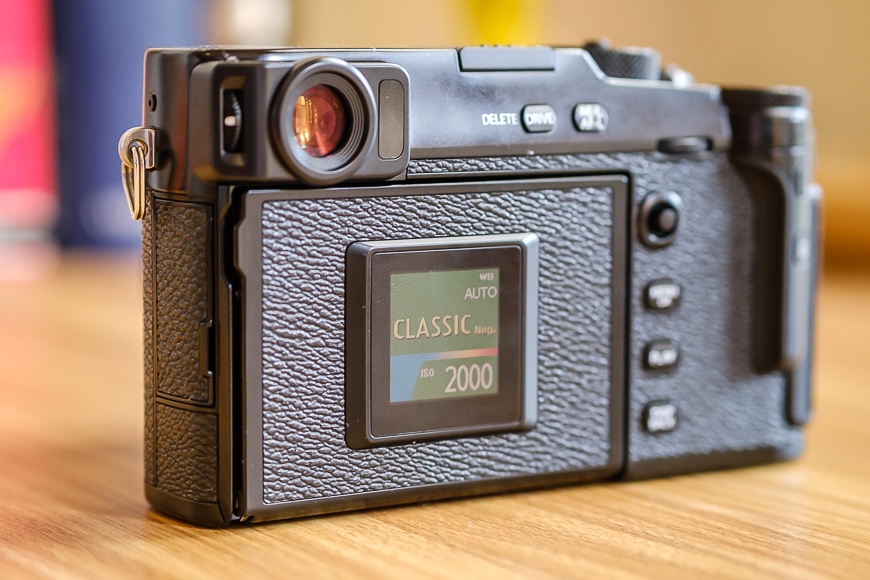
The Fuji X-Pro3 has a truly unique and retro style to it. The LCD is hidden, and you have constant access to the sub-monitor for film simulation and shooting data.
When it comes to image quality, the X-Pro3 uses the latest technology from Fujifilm to deliver exquisite images regardless of the lighting conditions.
It houses the newer Fujifilm X-Processor Pro and the latest CMOS X-Trans IV image sensor. for stellar image quality.
While a cropped sensor like this may not be able to deliver the high-detail images of a full-frame sensor, the Fuji X-Pro3 performs admirably, making us question the need to move to full-frame at all.
When it comes to video, the Fuji X-pro 3 has improved on its previous iteration as it supports full 4K video at up to 29.97p.
While not marketed as Fuji’s flagship model for video, the X-Pro 3 produces exceptional video quality, especially with the relatively recent Eterna film simulation.
The styling and design of the X-Pro series have always held the spotlight thanks to its rangefinder and retro camera aesthetics – it’s a digital camera that looks like a film camera.
It is a great-looking camera and adds something special to your shooting experience, with many first observers believing it to be a film camera.
The Fuji X-Pro3 has an incredible build quality, solid magnesium frame, and titanium top and base plates. You could seriously hammer a nail into the wood with this camera…
The standard version is black and has a very stealthy look to it, making it perfect for street photography.
Two additional variations, including Duratech Black and Duratech Silver, have a special Titanium coating that is scratch-resistant, adding to its aesthetics and durability.
Who is the Fujifilm X-Pro3 for?
The Fuji X-Pro-3 is the latest flagship camera meaning that it will suit advanced amateurs and professionals. The biggest attraction to this camera will be the outstanding image quality, retro styling and the unique hybrid viewfinder.
The key difference between this camera and the new X-100V is that the X-Pro-3 has interchangeable lenses.
If you love the look and feel of old-school film cameras with retro styling, then this camera will give you all of that plus the latest state-of-the-art digital technology Fujifilm can muster. It is the best of both worlds and will deliver exceptional image quality through a full range of in-camera features and functions.
4. Fujifilm X-T200 | Least Expensive X-Series Camera with Viewfinder
Size: 121.0(W) mm x 83.7 (H) mm x 55.1(D) mm / 4.8 in.(W) x 3.3 in. (H) x 2.2 in. (D)
Weight: 370 g (13 oz.)
Sensor: APS-C CMOS
Megapixels: 24.2
- Simple menu and camera controls
- Physical dials, despite the size
- Great autofocus
- Improved handgrip
- Inexpensive
- Pocketable size
- Easy to use
- Built-in EVF
- Tilting touchscreen
- Excellent image quality
- 4K video @ 29 fps
- Not a good fit for larger hands
- Sluggish in general
The Fujifilm X-T200 is a super-compact entry-level mirrorless designed to appeal to mobile phone users who want to enter photography – much like the X-A7.
Unlike the less expensive X-A7, the X-T200 has a built-in electronic viewfinder and more advanced settings, allowing for greater creative control.
It’s actually Fuji’s least expensive X-series camera that includes an electronic viewfinder – most photographers I know prefer having a viewfinder to compose their images, especially in strong sunlight.
It comes with a 3-way tilt touch screen and improved video ability with 4K at 29.97P for up to 15 minutes – making this a brilliant camera for vloggers.
This upgraded version from the original X-T100 has a new and improved grip making it far easier to hold – especially for those of us with bigger hands.
The Fuji X-T200 is about half the weight of many of the more advanced X-series cameras, but still manages to feature a decent 3-inch tilting touchscreen and viewfinder.
Talking of the screen, a key feature for all the vloggers out there is the ability to flip the screen to the front.
This means that when combined with a wide-angle lens, the Fujifilm X-T200 can be used to film yourself at arm’s length – fortunately, there’s also an external 3.5mm mic input, HDMI and USB-C connectors.
The huge 16:9 ratio touchscreen allows for full menu control as well as a simple icon menu system that will be appealing to smartphone photographers.
As expected on a Fujifilm camera, the X-T200’s images come out sharp and detailed. The image sensor is vastly improved over the previous X-T100 model resulting in greater low-light performance.
The colours and tonality are the expected Fuji-beautiful, and the film simulation mode is a lot of fun. The sensor works beautifully, and the camera itself is a miniature beauty in its own right – I love the graphite/black colourway.
Unfortunately, the kit lens that often comes with the X-T200 is sluggish on the focus.
However, you have a huge range of cheap primes and zooms available. If you’ve never worked with interchangeable lenses before and want to try them out, this is a great place to start.
In terms of shooting performance, it’s clear that this is Fuji’s entry-level option – autofocus speed is sluggish, as is the camera operation in general.
However, it has to be said that if you’re coming straight into the Fujifilm system and this is your first experience outside of a smartphone, you probably won’t notice any of the slowness – it’s only when you start to compare to the more expensive cameras in their lineup that you’ll see the difference.
If you’re looking for a hassle-free entry-level mirrorless camera that can be had for less than 700 bucks, you can’t wrong with the Fujifilm X-T200. The front-flip LCD screen is also unique on an inter-changeable camera at this price point.
Who is the Fujifilm X-T200 for?
The X-T200 is the perfect first camera for someone new to photography or wanting to step up from smartphone photography. It’s simple to operate yet offers room to grow into more advanced creative control. It also happens to be Fuji’s least expensive interchangeable lens mirrorless with a built-in viewfinder.
If you’ve got a limited budget, the mid-range X-T200 is the cheapest way to take advantage of all the amazing Fujinon lenses, not to mention those film simulation modes that have made Fujifilm cameras so desirable.
It’s also a great second camera for the pro or advanced amateur when they don’t want to lug around all their heavier gear – just be aware that there’s only one card slot.
5. Fujifilm X-T30 | Great Value Fuji Compact Camera
Size: 118.4 x 82.8 x 41.4 mm (4.7 x 3.3 x 1.6 in.)
Weight: 383 g (13.5 oz.)
Sensor: APS-C X-Trans CMOS III
Megapixels: 26.1
- Feature-packed compact camera
- 425-point phase-detect autofocus system
- Excellent face detection capabilities
- The same sensor as the X-T3, but at a much lower price
- Small and light
- 4K video
- No IBIS
- Viewfinder not designed for those who wear glasses
- Can only shoot 10 minutes of video at a time
- Newer model available
The Fujifilm X-T30 is essentially a smaller, lighter version of the X-T3. It uses the same processor, same phase-detection system, and even the same frame rate capability.
If you want the X-T3 or X-T4 but can’t afford it, this is definitely the camera to buy since it’s the cheapest Fujifilm camera which offers film simulation.
It also makes a great backup body to the X-T3 or X-T4, but remember, there’s only one card slot.
If Fujifilm had provided a dual card slot, I don’t see any real reason that professionals would keep buying the X-T3 over this little pocket rocket.
In fact, the X-T30 has enhanced face detection and eye tracking. You can now choose the face that you want to lock on to, which is great when shooting crowds of people when you need to hone in on just one subject.
It also has a few additional functions designed to cater to the less professional photographer (i.e. Advanced SR Auto, etc.).
Also, the Fujifilm X-T30 is somewhat smaller, which will be a big plus for travel photographers.
The only real trade-offs for going with the X-T30 are a limited buffer, fewer body controls (it’s a smaller camera), no weather-proofing and only one card slot.
Otherwise, it’s essentially the same camera as far as still photography is concerned.
Video is really the only place where you might be disappointed with the Fujifilm X-T30’s performance, and that’s primarily because you’re limited to 10-minute clips.
(I suspect this is because the camera’s so small – it would probably overheat if it went longer.)
Still, during those 10 minutes, it can record 8-bit 4:2:0 video directly to the SD card or 10-bit 4:2:2 video to an external recorder. That gives you plenty of post-processing leeway.
It also comes with the Eterna film simulation for those who don’t want to spend time colour grading – Eterna gives a soft, muted look to the overall image, making it particularly suited for skin tones.
Eterna has actually been one of the most compelling reasons for videographers to use the newer Fujifilm cameras that offer it – the flat, low-saturation look offers more flexibility for post-production but also looks beautiful straight out of the camera.
For photographers, Eterna can be applied to stills on the Fujifilm X-T30, too, offering a truly unique look to the final JPEG – somewhere between Classic Chrome and ProNeg Std. I like to use it in the early morning (blue hour) when shooting outside.
Overall, considering the X-T30 retails for a full $500-$600 less than the X-T3, you’re getting an amazing camera. If you want the exceptional performance and features of the X-T4 but don’t have the cash, the X-T3o is really your best bet.
Who is the Fujifilm X-T30 for?
The Fujifilm X-T30 is for those who want the quality of the X-T3 or X-T4 but don’t want to fork out the cash.
Amateurs, hobbyists and pros will all love this camera. Basically, it’s for everyone who doesn’t need the features of a full-frame, wants top-of-the-line features otherwise and is looking to spend less than $1,000.
In my mind, it’s only the hardened professional who absolutely needs a weather-proof body with dual card slots who would pay the extra to get the X-T3 or X-T4.
The Fujifilm X-T30 is an absolute bargain of a camera – this much technology packed into such a stylish body at an affordable price is a true rarity, but Fujifilm has managed to accomplish it.
6. Fujifilm X-A7 | Best Fujifilm Camera for Beginners
Size: 119.0(W) mm x 67.7 (H) mm x 41.1(D) mm / 4.7 in.(W) x 2.7 in. (H) x 1.6 in. (D)
Weight: 320 g (11 oz.)
Sensor: APS-C CMOS
Megapixels: 24.2
- Sharp, top-quality images
- Great colour and tonal reproduction
- Front-flip LCD screen
- Easy to use
- Compact
- Relatively inexpensive
- Face/eye detection focus
- Sluggish autofocus with kit lens
- No electronic viewfinder
- Awkward to use
If you’re looking to make your first foray into the world of mirrorless cameras and don’t want to spend a lot of money, the Fujifilm X-A7 is a great choice. Plus, over its previous incarnations, the Fuji X-A7 has had some serious upgrades.
Its large sensor and interchangeable X-series lens system open up a whole world of photography beyond the smartphone without being too complex for novice users.
As one of Fuji’s least expensive X-series mirrorless cameras, the Fujifilm X-A7 doesn’t have a viewfinder, but the simplified, user-friendly controls paired with its exceptional image quality make it a great entry-level camera.
The X-A7 features a large 16:9 ratio LCD touchscreen that can face the front – perfect for filming yourself vlogging or for that all-important selfie shot – there are even in-camera selfie settings that help you look your best!
Leave it on Auto to take advantage of its excellent point-and-shoot capacities, or delve into its manual controls and get more creative.
Either way, the Fujifilm X-A7 is an excellent camera for first-timers or smartphone shooters who are looking to go deeper into the world of photography.

The Fuji X-A7 features a huge 16:9 ratio touchscreen with simple icon menu controls
Fortunately, the autofocus on the X-A7 has been greatly enhanced thanks to its new sensor and processor. However, the included kit lens is terribly sluggish to the detriment of the performance of the camera.
If you find it too slow, then I’d recommend buying the body only and pairing it with a better zoom lens or investing in a fast prime.
It’s also a good idea to invest in a better lens if you want to do a lot of low-light photography. With the new sensor, low light performance has greatly improved on this camera – noise is less of an issue when shooting at higher ISO.
As far as video is concerned, the full HD video quality is high-quality. This has been boosted to shoot a respectable 4K video at 29 fps making this a perfect camera for vlogging or for holiday videos.
Overall though, the X-A7 is an impressive little Fuji camera for beginners that’ll slide into your jacket pocket with ease.
It takes great photos (both Raw and Jpeg), is available in a range of colours (the fake-leather accents are a nice touch), and offers a low-priced entry point to the great X-mount Fujinon lenses.
Who is the Fujifilm X-A7 for?
The Fujifilm X-A7 is perfect for those who are looking to upgrade from their smartphones and explore the interchangeable lens world.
It’s beginner-friendly, won’t break the bank, and allows you to invest in X-series lenses while upping your game on an easy-to-learn camera.
The styling is also clearly aimed at the fashion-conscious vlogger, with good-looking fake-leather side panelling that elevates the camera above plasticky point and shoots.
7. Fujifilm X100V | Best Fujifilm Compact Camera
Size: (W) 128.0mm × (H) 74.8mm × (D) 53.3mm /(W) 5.04in × (H) 2.94in × (D) 2.10in
Weight: 478g / 16.9oz
Sensor: X-Trans™* CMOS IV & X-Processor Pro
Megapixels: 26.1
- Awesome hybrid viewfinder
- A new sharp, fast lens
- The latest X-Trans IV sensor
- Highly customizable
- In-lens ND filter
- Compact, beautiful design
- Inconspicuous styling
- 17 film simulations
- Poor grip
- No dual card slot
- Limited weather sealing
- Hard to find in stock
Since its launch in 2010, the X100 series has seen a tremendous rise in popularity, culminating with the fifth generation Fujifilm X100V. And it is fair to say that this is the best of the best of the Fuji digital cameras.
I’ve owned previous generations and have always been impressed by the image quality produced by its fixed 23mm (35mm equivalent) f/2 lens combined with Fujifilm’s acclaimed X-Trans APS-C CMOS sensor.
Auto-focus was never a strong point for earlier iterations, but with the V model using the new faster 23mm f/2 Version II lens, autofocus is incredibly fast. ,
Fujifilm has created an incredibly versatile, high-quality rangefinder camera that oozes style. Forget the over-priced ‘red dot’ cameras out there – this little number beats them hands down in the aesthetic design stakes.
Whether you take advantage of the hybrid viewfinder or not (which allows you to choose from a conventional optical viewfinder with an electronic overlay or an electronic viewfinder), shooting with the Fujifilm X100V is an utter joy for street, documentary and travel photography.
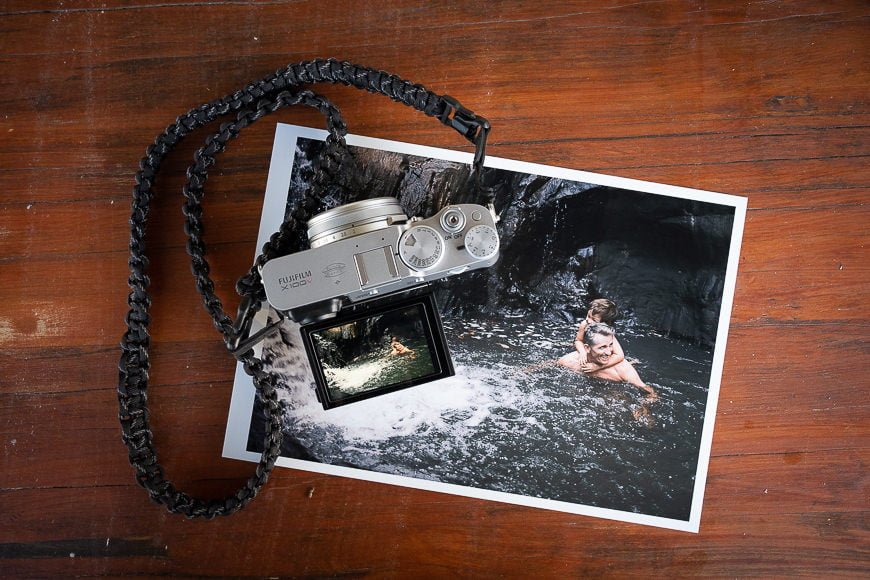
The X100V features numerous improvements and refinements over previous models, including the powerful third-generation 26.1 MP X-Trans CMOS IV sensor, X-Processor Pro image processor, smart button layout with joystick AF control, Built-In ISO dial, new film simulations, new lens and more.
If you shoot single-point AF mode like I do, having a joystick or joypad to manually control the AF point is an absolute must.
The refresh rate and clarity of the EVF are incredible, making the EVF seem even more like you’re looking at an OVF.
A continuous shooting mode up to 11 fps combined with a larger buffer and improved AF system means that the Fujifilm X100V can keep up with fast-moving action, too… although I’d never call this a camera for sports photography by any stretch.
I particularly enjoy the X100V due to the limitations imposed by its fixed lens – despite all the amazing Fujinon X-mount lenses available, I sometimes prefer the simplicity of having a camera with no lens options… and thanks to the incredible sharpness/contrast of the built-in new 23mm f/2 II, I don’t feel like I’m missing out on anything. Trully one of the most enjoyable Fujifilm point and shoot to have ever come out in recent times.
The built-in ND filter is also a great touch and something I find myself using it a fair bit when shooting the kids out in broad daylight – it’s nice to be still able to get a shallow depth of field with that gorgeous f/2 lens.
We haven’t mentioned the aesthetics of the camera yet, but it goes without saying that this is one gorgeous camera to look at and hold.
The retro-rangefinder-inspired styling is a sure hit for any photographer and is sure to attract some compliments.
(If you want to go a step further with some customisations, check out our article on accessories for the Fujifilm X100 cameras.)
Overall, I highly recommend this camera, whether you’re a professional or a beginner. The Fujifilm X100V is a fantastic all-round camera that’s perfect as an everyday workaround or even used to earn money as a pro photographer – just remember there’s only one card slot.
Who is the Fujifilm X100V for?
The tack-sharp lens, the professional image quality, and the no-hassle compact size make the Fujifilm X100V the perfect everyday carry camera for the dedicated photographer.
It’s a particularly convenient pocket camera for travel, street, or documentary photography.
If you’re looking for a Fuji camera that can shoot beautiful straight-out-of-camera JPEGS, as well as competent RAWs, but don’t have time for multiple lenses, this is definitely the camera for you. It also happens to be an absolute joy to use.
8. Fujifilm GFX100S | Best Medium Format Fuji Camera
Size: 150 x 104 x 87 mm
Weight: 900g
Sensor: 102MP BSI-CMOS 44 x 33mm medium format sensor
Megapixels: 102MP
- Exceptional image quality resolution from 102MP sensor
- A raft of film looks available to use
- Compact for a medium format camera
- Versatile dual-hinge rear display
- In-camera RAW processing
- 400MP multi-shot mode
- Fast autofocus performance
- Competitively priced
- 8-way joystick takes a little getting used to
- File sizes are very large
- Buffer fills quickly when shooting with burst capture
- Expensive
Hobbyists and professional photographers alike have become accustomed to the advantages offered by full-frame mirrorless camera systems, preferring their versatility and lighter weight for their shooting style.
The Fujifilm GFX100S is their latest medium format camera, delivering a larger sensor that opens up new possibilities for photographers who are looking to move beyond the limitations of full-frame format cameras and take on a new perspective.
Featuring many of the core features available on their much pricier medium format camera, the GFX 100, the GFX100S boasts a surprisingly small body that belies the workhorse technology that makes it as capable as many more expensive medium format cameras from Fuji’s competitors.
This impressive power and performance begin with the 102MP BSI-CMOS 44 x 33mm medium format sensor, taking the technology from the GFX 100 with the new image stabilisation system that’s rated at up to 6EV, making it as groundbreaking as the GFX 100 but a fraction of the price.
Its compact body, shorter and slimmer than other GFX models, weighs in at just 900g and is comfortable to operate thanks to the textured rubber grip and familiar PASM dial and control layout, with all buttons easily accessible while shooting.
There’s also a handy top display located beneath the shutter button, displaying a range of useful information such as ISO, shutter speed, aperture, and more shooting parameters, which can be further customised to display the user’s preferred settings.
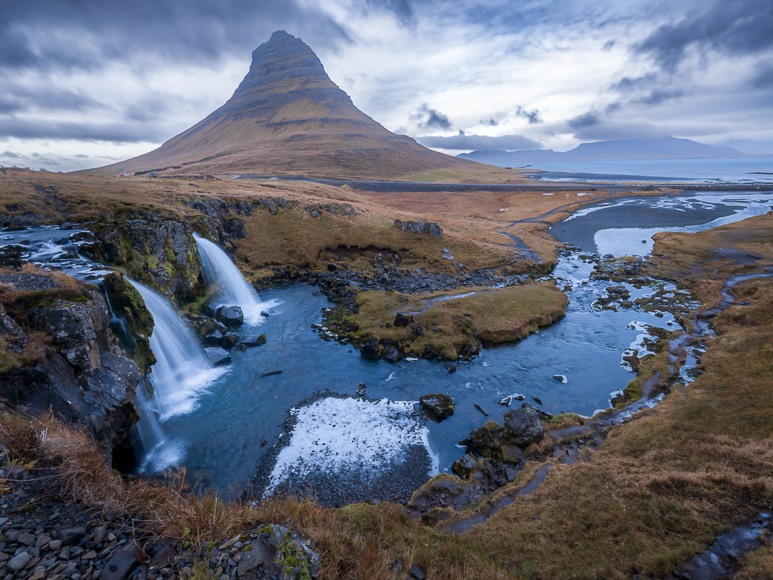
Fuji GFX100s + 20-35mm f/4
Fujifilm’s trademark Q menu is available with the GFX100S, so photographers who are taking their first step into the world of medium format cameras will find themselves at home when navigating the various settings to program the camera to their desired preferences.
Now that I’ve covered the design, ergonomics and overall functionality of the GFX100S, it’s time to move onto the performance side of the camera, which is as professional and versatile as you’d expect from a camera with a price running into the thousands.
The inclusion of exceptional image stabilisation, something that Fujifilm touted as a core benefit for the GFX100S, allows for much more accurate compositions and high-quality images when shooting handheld with longer shutter speeds.
It makes the GFX100S an outstanding performer for handheld work, which is especially impressive when considering the high-resolution sensor combined with the focal plane shutter and the camera’s ability to synchronise with OIS lenses for stability when shooting with longer focal lengths.
Likewise, the camera’s phase detection autofocus places the GFX100S in the top league when it comes to other medium format cameras, establishing focus by reading incoming light rays as opposed to the contrast detection of rivals, making it more adept at setting focus on subjects that are in motion.
The camera does a fantastic job of setting focus on its own, but there’s also the option to set your own focus point using the rear focus joystick, as well as using the camera’s face and eye detection for human subjects and various other non-human subject types.
It’s perhaps not as impressive as the autofocus features found on some of the best full-frame camera systems, but as far as medium format cameras go, the autofocus with the GFX100S is a top-tier performer that will rarely let you down.
As you’d expect from a 120MP camera, images are incredibly rich and detailed, delivering a huge amount of leeway for cropping and other adjustments in post-production, with lots of dynamic range across the settings to play with.
While most photographers who are using a medium format camera such as this will no doubt focus on RAW for processing, the excellent film simulation modes which are available in many other Fuji cameras can be found here and can be applied when shooting in JPG mode.
The icing on the proverbial cake is the multi-shot capture mode for when shooting on a tripod, offering much-improved colour sampling and a 400MP output which can then be combined and processed using the Fujifilm Pixel Shift Combiner software.
Who is the Fujifilm GFX100S for?
Medium format cameras offer a more specialist set of tools that are typically associated with landscape and professional fashion photography and come at a high price point that deters most amateur enthusiasts from taking the plunge.
While the Fujifilm GFX100S is certainly expensive, it’s considerably more affordable than many of its medium format competitors from brands such as Canon and Hasselblad and roughly half the price of their own GFX 100.
Any photographer who’s considering making the move to medium format cameras is going to anticipate the additional cost, and the Fujifilm GFX100S is arguably the best all-around camera in this category, with exceptional resolution and some of the best images on the market.
The idea of an “entry-level” medium format camera seems redundant, considering the cost. Still, if any model were to be a contender for this label, it would be the Fujifilm GFX100S, offering a surprisingly accessible shooting experience with a relatively lightweight camera.
9. Fujifilm GFX 100

Size: 156.2mm (W) × 163.6mm (H) × 102.9mm (D) / 6.15in. (W) × 6.44in. (H) × 4.05in. (D)
Weight: 1,400g / 49.4oz.
Sensor: 43.8mm x 32.9mm Bayer
Megapixels: 102
- Insane image quality from 102MP sensor
- Great handling
- Excellent price for a modern medium format digital camera
- Great customization ability
- Weather sealing
- Interchangeable EVF
- Very expensive
- Slow continuous shooting speed
- Massive body
- Poorly designed thumb rest
When you first see and pick up the Fujifilm GFX100, you are almost immediately intimidated by its size.
With the appearance of a Fuji X-T4 with a battery grip, it still holds that true Fuji retro design.
This truly is a beast of a camera for a good reason, as it’s sporting a whopping 102-megapixel sensor.
At the end of 2016, Fujifilm came out with one of the first mirrorless medium-format cameras ever: the Fujifilm GFX 50S (review).
Before long, the rumours of Fuji’s continued pursuit of a medium format camera were circulating, that a 100-megapixel camera was on the way.
This generated a lot of excitement amongst fashion and portrait photographers who were already enjoying the other GFX cameras and lenses.
Price-wise, the GFX100 is by no means an impulse-buy kind of purchase. Coming in at the same price as a second-hand car, you really have to be serious about return on investment.
In terms of its size, the mirrorless GFX100 is more like a chunky Fujifilm DSLR, if one actually existed.
The GFX100 produces images with insane levels of detail thanks to its exceptional image-capturing performance, all within a familiar Fuji retro body packed full of features.
Basically, this is a rare beast in the photography world and is the envy of every camera manufacturer that Fuji was able to bring to market such an incredible camera.
Thanks to the massive 102-megapixel sensor, far larger than a full-frame camera sensor, the GFX100 is producing exceptional image performance across all aspects, including sharpness, colour science, low light performance and noise management like no other camera.
You will not believe your eyes when you see the quality of images either on a quality monitor or even printed out in a large format.
Thanks to an exceptional range of Fujinon GF lenses, you have the ability to achieve incredible fall-off from the in-focus to out-of-focus elements.
In addition, the dynamic range is great too. The high-resolution files provide seemingly endless editing flexibility, even in JPEG images.
The GFX100 boasts an impressive shutter speed of 1/4000 in mechanical and 1/6000 in electronic shutter.
Despite its size, the GFX100 is still a relatively portable camera and would perform exceptionally well in wedding and portrait photography.
Thanks to its comprehensive weather sealing, you will not hesitate to get out and about with this camera to capture gorgeous images, not just in the studio setting.
The build quality of this GFX camera is outstanding, with a retro feel that in no way compromises ergonomics and handling.
Due to its size, the GFX100 has a built-in handgrip that houses dual batteries and provides additional controls for portrait orientation shooting.
Whilst a heavy beast of a camera, it’s still very easy to work with, and the interchangeable EVF provides flexibility in how you operate the camera.
Control dials and buttons have been sensibly placed to ensure ease of use and familiarity of control, and there are terminal ports for studio shooting or for videography built-in.
Whilst not the most practical camera for video, most medium-format cameras are ineffective at video. The GFX100 does shoot 4K at 30p, which is pretty respectable.
When it comes to autofocus, the GFX100 has vastly improved over the previous GFX models as the hybrid autofocus system performs at a similar capacity to a Fuji mirrorless camera. Face and eye detect operate as expected and overall the focusing system is fast and sharp.
Thankfully, the Fujinon GFX lens range is growing with 7 primes and 3 zooms available, with more promised in the near future.
There are also much fewer lens options out there for Fuji’s medium-format cameras, although the roadmap does promise some interesting options for the future.
When it comes to price, the GFX100 is up there with the best of them, although not nearly as expensive as a Leica medium format camera, for example.
In addition, no other competitor has the capacity to create such highly detailed images nor boasts a 102-megapixel sensor.
Traditionally medium-format cameras have been developed for slower and more intentional shooting conditions, such as being in a studio or setting up a cracker of a landscape shot.
However, the GFX100 seems to break from the class with its faster autofocus and relative portability. There is no reason why you could not employ this camera for weddings, events or even, dare I say, street photography.
If you are looking at medium-format as a serious next step in your pro photography, the GFX100 is an incredible option to have as you will be creating images with world-class levels of detail and dynamic range.
Who is the Fujifilm GFX100 for?
The Fujifilm GFX100 is a camera designed for serious photographers looking for exceptional image quality from a medium format camera.
If you work in a commercial photography business that covers fashion, models and advertising, then having the capacity to capture such highly detailed images will set you apart from the rest with the GFX100.
And as mentioned, there is no reason why you cannot take this camera out and about for use in every setting and genre. Imagine being able to capture astrophotography with a 102-megapixel sensor, for instance.
10. Fujifilm X-T30 II | Best Compact Fuji Camera for Travel
Size: 118.4 mm × 82.8 mm × 46.8 mm
Weight: 378g
Sensor: X-Trans CMOS 4 sensor
Megapixels: 26MP
- Beautiful throwback styling
- Plenty of excellent film simulation modes
- Uncropped 4K
- Easy to pick up and shoot with right away
- Lightweight and portable
- Fantastic JPG image quality
- An excellent fully formed lens system
- Built-in flash
- Tracking focus with up to 30fps capture
- LCD screen not ideal for vlogging
- Battery life could be better
- Viewfinder is a little on the small side
Having already covered the Fujifilm X-T30 in detail above, their compact and traveller-friendly alternative to the more comprehensive X-T3, it’s time to turn our attention to the latest iteration in this line of cameras, the X-T30 II.
Many of the core design decisions, features, and settings available in the previous version are present and correct with the X-T30 II, including the same retro-style body and the same 26-megapixel X-Trans BSI CMOS 4 APS-C sensor for excellent images.
Likewise, the X-T30 II incorporates the same X-processor 4 image processing engine and is capable of DCI 4K video recording up to 30p, with a matching extended ISO range of 80-51200.
Many of the camera’s settings and tools have also been ported over directly from the previous model.
Now that we’ve covered some of the similarities let’s take a look at the new features and design choices Fuji has brought into play with the X-T30 II that sets it apart from its predecessor and might tempt users to take the plunge and upgrade (or entice first-timers to invest).
These include a selection of incremental upgrades such as a higher resolution screen for monitoring your shots, now at 1.62 million dots, and several changes under the hood that improve performance across still photography and videography.
The inclusion of a new autofocus system is a welcome addition to the X-T30 II, with better performance in low-light conditions, improved customisation options, and a larger photo buffer for sports and wildlife photographers who enjoy using the camera’s continuous shooting mode.
For filmmaking and video content creation, the Fujifilm Z-T30 II introduces longer video recording times than was available on the X-T30, making it a more viable option for run-and-gun filmmakers looking for a lightweight yet high-performance camera to film with on the move.
Additional improvements, such as the inclusion of Wi-Fi and Bluetooth connectivity, along with USB charging, certainly make the camera more hassle-free, although these are hardly going to be game-changers for anyone who is currently using the X-T30.
While these upgrades might not be enough to warrant reinvesting in this newer model if you’re an existing X-T30 owner, those who are looking for a great compact camera that allows for interchangeable lenses will find a great deal to be enthusiastic about.
For photography, there are Fuji’s trademark film simulation modes to get plenty of enjoyment out of, and it’s a capable camera for video, too, with up to 30 minutes of 4K video recording available, compared to the 10 minutes previously available on the X-T30.
With that said, the LCD display lacks the ability to swing out to face the side or forward, which means there’s no selfie mode available for vlogging, limiting its suitability for content creators who upload to YouTube and TikTok.
It’s a minor gripe for a camera that is first and foremost intended to be a fun and easy-to-use alternative to more complex models from Fuji, coming in at a fraction of the price of their X-T series cameras while still retaining many of their core features.
Who is the Fujifilm X-T30 II for?
The X-T30 II represents only a marginal upgrade over the X-T30, and photographers who currently own the latter are unlikely to view these changes as enough to warrant reinvesting in Fujifilm’s newest offering.
With that said, anyone who is looking for a beginner-friendly camera that marries excellent features with a user-friendly learning curve will get a great deal of value for money from the X-T30 II, which combines an impressive sensor and AF system with a wonderfully tactile body design.
More experienced photographers who want to expand their gear with a lightweight backup camera will also find the X-T30 II a tempting proposition, particularly those who are already familiar with Fuji’s interfaces and custom options found in their other models.
11. Fujifilm X-S10 | Best Fuji Camera for Vlogging
Size: (W) 126.0mm × (H) 85.1mm × (D) 65.4mm (minimum depth 32.9mm)
Weight: 465g
Sensor: X-Trans CMOS 4 with primary color filter
Megapixels: 26.1 million
- Powerful 26MP X-Trans BSI-CMOS sensor
- In-body image stabilisation across 5 axes
- Handy front-facing display
- Great autofocus
- Wi-Fi and Bluetooth connectivity
- Impressive video specifications
- Solid grip and handling
- 30 fps burst shooting
- Battery life could be better
- The body lacks weather sealing
- Only one UHS-I memory card slot
The Fujifilm X-S10 is the lightest camera in the company’s X series to feature in-body stabilisation, which, together with its 4K recording and front-facing screen, makes it a great model for active vloggers and travel photographers.
Representing a new body style for Fuji, it’s in the middle ground between the X-T30 and the X-T5, with a deeper grip that makes it more compatible with larger lenses while still being relatively small and light for ease of use.
As Fuji’s flagship mid-range mirrorless camera, it takes the IBIS and combines it with the 26.1MP X-Trans CMOS 4 sensor and X-Processor 4, replacing the familiar array of manual dials found on other Fuji cameras and replacing it with the PASM (Program, Aperture, Shutter Speed, Manual) dial typically found on DSLRs.
At the same time, the design, build, and functionality feel more in line with modern cameras, with flexible performance whether you’re shooting in video or capturing stills and an intuitive user interface that’s a little less daunting than some of Fuji’s upmarket cameras.
Ironically, photographers who are already immersed in Fuji’s camera range might be more put out than those coming to the X-S10 from Nikon or Sony cameras, which have more in common with the layout of buttons and controls found here.
In addition to its pared-back handling, the X-S10 delivers solid autofocus performance that complements the inclusion of IBIS and helps ensure tight and accurate images, mixing contrast and phase detection to track moving subjects.
There’s the option to select face and eye detection, with a subject tracking mode locking onto a target and allowing for consistent results when shooting in burst mode, which can be set to 10fps and 20fps (or 30fps in a cropped capture mode at 16.6MP).
This combination of the lightweight body, effective autofocus, and in-body stabilisation makes the X-S10 an ideal camera for handheld photography, capable of long handheld exposures even when using a lens that lacks its internal stabilisation.
Image quality in this new Fujifilm camera is as good as you’d expect from the sensor it uses, with sharp and clear photographs that reproduce colours with vibrancy and the handy inclusion of in-camera Raw processing that enables on-the-fly editing of your shots.
There’s plenty of dynamic range to play with, too, and the Fuji X-S10 is as capable as the more expensive X-T5 in this regard, particularly when dealing with images shot with a low ISO value.
Switch from Raw to JPGs, and you’ll get the Fujifilm signature vintage film stock simulations, including Classic Chrome, Negative, Velvia, Astia, and a selection of monochrome effects, each of which gives your images its own unique aesthetic.
With its forward-facing display, the X-S10 is also a wonderful camera for vlogging, with up to 4K recording at 30fps in addition to 120fps and even 240fps for impressive slow motion, albeit with a sacrifice in resolution to achieve this effect.
The same film simulation looks available for stills photography can also be used with video, and there’s also a flat F-Log profile for more adventurous or professional videographers who prefer to colour grade their footage after a shoot.
If that’s a part of your workflow, there are many LUTs (look-up tables) available directly from Fujifilm you can download from their website to use with F-Log and Eterna, which can help speed up the process of achieving a distinct and refreshing look.
While the Fujifilm X-S10 is still relatively expensive for a consumer camera, it blends the processing power and IBIS typically found in more expensive models into a compact package that will nevertheless still appeal to more casual photographers and vloggers.
Who is the Fujifilm X-S10 for?
Amateur and hobbyist photographers who are interested in breaking into the mirrorless camera market but aren’t sure about spending the money needed for Fuji’s flagship X-T5 will find many of the features and settings in the cheaper X-S10.
A solid all-rounder, the X-S10 is both a capable stills camera and a reliable performer for videography, with a premium-standard body design and simplified controls that will give relatively inexperienced photographers a shallower learning curve.
The inclusion of IBIS, in addition to the forward-facing screen, makes the X-S10 the perfect choice for budget-conscious vloggers and travel photographers who want a versatile camera for largely handheld photography and videography.
Fujifilm Mirrorless Camera Comparison List (APS-C)
If you need a Fujifilm X-Series comparison, check out the guide below:
Fujifilm X-T5 (2022)
- 40.2 megapixels X-Trans CMOS 5 HR sensor
- 7-Stop 5-axis in-body image stabilization
- 3.69m-Dot OLED Electronic Viewfinder
- 3″ 1.84m-Dot Tilting Touchscreen LCD
- 4K 120p, 6.2K 30p, FHD 240p 10-Bit Video
- Body dimensions: 130 mm x 91 mm x 64 mm
- Body weight: 607g
Fujifilm XH2S (2022)
- 26-megapixel backside-illuminated APS-C layered construction
- 3″ A fully articulating 1.62 million-dot LCD
- 5.76 million-dot EVF with 0.8x magnification
- 4K 120p video recording of 4:2:2, 10-bit h.265
- Body dimensions: 136.3 mm × 92.9 mm × 84.6 mm
- Body weight: 660g
Fujifilm XH2 (2022)
- 26-megapixel backside-illuminated APS-C layered construction.
- 3″ A fully articulating 1.62 million-dot LCD
- 5.76 million-dot EVF with 0.8x magnification
- 6.2K 30p video recording of 4:2:2, 10-bit Apple ProRes HQ, ProRes 422, ProRes LT, and ProRes 422 Proxy
- 4K 120p video recording of 4:2:2, 10-bit h.265
- Body dimensions: 136.3 mm × 92.9 mm × 84.6 mm
- Body weight: 660g
Fujifilm X-S10 (2020)
- 26.1 MP APS-C BSI-CMOS Sensor
- X-Processor 4 Image Processing Engine
- 3.0 inch 1.62 million dot tilting LCD screen
- 4K Video Recording
- Body dimensions: 126.5mm x 74.8mm x 53.7mm
- Body weight: Approx. 583g (including battery and memory card)
Fujifilm X-T4 (2020)
- 26.1 MP APS-C BSI-CMOS Sensor
- X-Processor 4 Image Processing Engine
- 3.0 inch 1.62 million dot tilting LCD screen
- 4K Video Recording
- Body dimensions: 140.5mm x 97.3mm x 63.8mm
- Body weight: Approx. 526g
Fujifilm X-Pro3 (2019)
- 26.1 MP APS-C X-Trans CMOS 4 Sensor
- X-Processor 4 Image Processing Engine
- 3.0 inch 1.62 million dot tilting LCD screen
- 4K Video Recording
- Body dimensions: 140.5mm x 82.8mm x 46.1mm
- Body weight: Approx. 645g
Fujifilm X-T3 (2018)
- 26.1 MP APS-C X-Trans CMOS 4 Sensor
- X-Processor 4 Image Processing Engine
- 3.0 inch 1.04 million dot tilting LCD screen
- 4K Video Recording
- Body dimensions: 132.5mm x 92.8mm x 58.8mm
- Body weight: Approx. 539g
Fujifilm X-H1 (2018)
- 24.3 MP APS-C X-Trans CMOS III Sensor
- X-Processor Pro Image Processing Engine
- 3.0 inch 1.04 million dot tilting LCD screen
- 4K Video Recording
- Body dimensions: 140.5mm x 83.8mm x 92.8mm
- Body weight: Approx. 673g
List of Fujifilm FinePix Series Cameras
Fujifilm FinePix 30i (2001)
Fujifilm FinePix 40i (2000)
Fujifilm FinePix 50i (2001)
Fujifilm FinePix 1300
Fujifilm FinePix 2300 (2001)
Fujifilm FinePix 2500 Zoom
Fujifilm FinePix 2600 Zoom (2001)
Fujifilm FinePix 2650
Fujifilm FinePix 2800 Zoom (2001)
Fujifilm FinePix 3800 (2002)
Fujifilm FinePix 4500
Fujifilm FinePix 4700 Zoom (2000)
Fujifilm FinePix 4800Zoom (2001)
Fujifilm FinePix 4900 Zoom (2000)
Fujifilm FinePix 6900 Zoom (2001)
Frequently Asked Questions
Is There a Fujifilm Full Frame Camera?
No, Fujifilm does not produce a full-frame camera. Instead, Fujifilm has focused on two main sensor sizes: APS-C sensors, which are used in their X-series cameras, and medium format sensors, which are used in their GFX series. The company has expressed its commitment to these formats and has not indicated plans to produce a Fujifilm full frame mirrorless camera.
Are Fujifilm Cameras good for photography?
Fujifilm has created an impressive lineup of cameras that use the latest technology to deliver outstanding results. While the two giants of the camera scene – Nikon and Canon – still have legions of dedicated fans, many photographers have been making the switch to Fujifilm without regrets.
Is Fujifilm good for video?
Yes – generally speaking, Fuji cameras offer excellent video recording capabilities. The Fujifilm X-T200 is a great one for YouTubers as it is light and also has a front-facing screen.
Which Fuji camera is best?
The best Fuji camera for you will depend on your needs. For the best all-around Fujifilm camera, our top pick is the Fujifilm X-T4. For travel, we love the Fujifilm X100V. If you’re after a small and lightweight point-and-shoot, we’d go with the Fujifilm XF10.
Where are Fujifilm cameras made?
The majority of Fujifilm cameras and lenses are made and manufactured in Japan.
Is there a list of Fujifilm full-frame cameras?
No such list exists because Fujifilm has never made a full-frame camera and probably never will. Their focus is on the APS-C sensor and, to a lesser extent, the medium format sensor.
What is the newest Fujifilm camera?
The X-T5 is the newest Fujifilm camera, released on November 2, 2022.
What are the upcoming Fujifilm cameras?
Fuji rumour sites discuss the following upcoming Fujifilm cameras for 2024: X-Pro4, Instax Wide 400, X100VI, X-E5 and X-T300. Although no one knows the release dates, it’s likely we will see these models appear in the coming months.
Should you buy a Fujifilm camera bundle?
Buying a Fuji X-Series camera as part of a camera + lens bundle is a smart way to save money over buying them separately. Since all X-series lenses are such high quality, you’ll be able to start taking photos right away, as opposed to having to wait to buy a lens.
Is Fujifilm X-T4 good for beginners?
If you have the budget for an X-T4, it’s a great camera for beginners, especially since the release of the X-T5, which should see prices of the previous model decrease. However, you can also get much cheaper Fujifilm cameras that would suit a beginner equally well.
Does Fuji X-T3 have IBIS?
No, the X-T3 lacks in-body stabilization (IBIS), which has become a common features in most other mirrorless cameras.
Does Fujifilm still make analog cameras?
Fujifilm only makes analog instant cameras, such as the Instax range. You can occasionally find old 35mm analog Fuji cameras on eBay, such as the Cardia Mini Tiara and Natura Classica.
Is there a Fujifilmn DSLR?
No, Fujifilm does not produce DSLR cameras, deciding to skip the DSLR market and focus on developing mirrorless technology, which has become increasingly popular in recent years. Fuji film cameras from the X-Series use APS-C sensors, while the GFX-series are medium format cameras.
What’s the best point-and-shoot Fuji camera?
If we define ‘point-and-shoot’ as a compact camera with a fixed lens, the Fujifilm X100 V is the best option. For those looking for a more budget-friendly or compact option, the Fujifilm XF10 is another point-and-shoot worth considering. It features a 24.2MP APS-C sensor and a fixed 18.5mm f/2.8 lens (equivalent to 28mm in 35mm terms).
What’s a Fujinon camera?
“Fujinon” is not a camera; rather, it’s the brand name for optical lenses produced by Fujifilm. Fujinon lenses are used in a variety of applications, from broadcast video lenses to binoculars and, most notably, lenses for Fujifilm’s X-series and GFX-series mirrorless cameras.
Best Fuji Cameras | Final Words

This was an especially difficult guide to write. The fact of the matter is every single Fuji camera on the market in 2024 could be a great choice for you.
The Fuji X series has cemented itself with its high quality, feature-packed, aesthetically pleasing, well-built, and, above all, enjoyable to shoot a range of cameras. This is why the Fujifilm X series gained much recognition among enthusiasts and fans alike.
Throw in Fujifilm’s years of experience creating some of the world’s finest film stocks, and you have a camera that can shoot in film emulation modes that would make any keen Instagrammer do cartwheels!
In this guide, I’ve selected what I believe are the best bang for your buck Fuji cameras, despite the presence of other fine models.
Hopefully, by seeing them all laid out in this one guide, you’ll be able to make an educated decision on which Fuji camera should have pride of place in your bag.
Now get out there and start shooting ;-)

Improved autofocus and image stabilisation combined with a glorious new 40MP sensor makes this good-looking camera the most desirable X-T model yet.





